- Forum
- categories
- Markets, finance and governance
- Global and regional political processes
- Sustainable Development Goals (SDGs), JMP monitoring
- specific definition of a "safely managed pit latrines" according to JMP ladder for sanitation and guide how to determine it in practice
specific definition of a "safely managed pit latrines" according to JMP ladder for sanitation and guide how to determine it in practice
15k views
Re: Specific definition of a "safely managed pit latrines" according to JMP ladder for sanitation and guide how to determine it in practice
It also implicitly includes a western cultural factor that has nothing to do with protecting human and environmental health (which is the definition of sanitation). Isn't this a very westernized idea to obsessively focus on non-shared toilets in the domestic sphere? Why would it be acceptable to use public toilets (at work, in school) and not shared toilets, bearing in mind the context (poor housing, non-asphalted roads, very low income and so on)?
As far as I can see, this negatively affects development projects as it does not encourage implementing partners to consider this solution in priority while the impact and efficiency is likely to be higher compared to individual toilets. In the field, depending on the culture, many people are happy to share their toilet with their neighbour. I have even seen the case where the toilet built by an NGO was not to the taste of the household, who then continued using the neighbours' toilet.
In my view monitoring factors should pay more attention to the cornerstone of sanitation i.e. protecting health and environment and in particular on the containment and treatment parts of the sanitation chain, rather than on the number of families using the interface.
Systems like a septic tank followed by a soak pit have been considered unsafe sanitation in Europe for a couple of years. The reason is well known. These systems have been in place for decades and resulted in wide underground water contamination, even when septic tanks are situated not 15 m but 35 m from a source of drinking / recreational water. Experience has shown that these systems do not protect health and environment and yet they are widely promoted in developing countries, including in the definition of safe sanitation in SDGs. Safely managed sanitation should include watertight septic tanks and a secondary treatment. This is probably difficult to achieve for financial reasons but not more not less difficult than non-shared sanitation.
MAKATI Environnement
Please Log in to join the conversation.
You need to login to reply- Elisabeth
-
- Moderator
- Freelance consultant since 2012 (former roles: program manager at GIZ and SuSanA secretariat, lecturer, process engineer for wastewater treatment plants)
Less- Posts: 3372
- Karma: 54
- Likes received: 931
Re: Specific definition of a "safely managed pit latrines" according to JMP ladder for sanitation and guide how to determine it in practice
Have a look at this presentation:
Towards national and global monitoring of faecal sludge management by Rick Johnston and Tom Slaymaker
Please log in or register to see it.
It was presented at the FSM 5 Conference in February of this year: fsm5.susana.org/en/downloads/conference-materials
I leave you with the second last slide:
Regards,
Elisabeth
Freelance consultant on environmental and climate projects
Attachments:
-
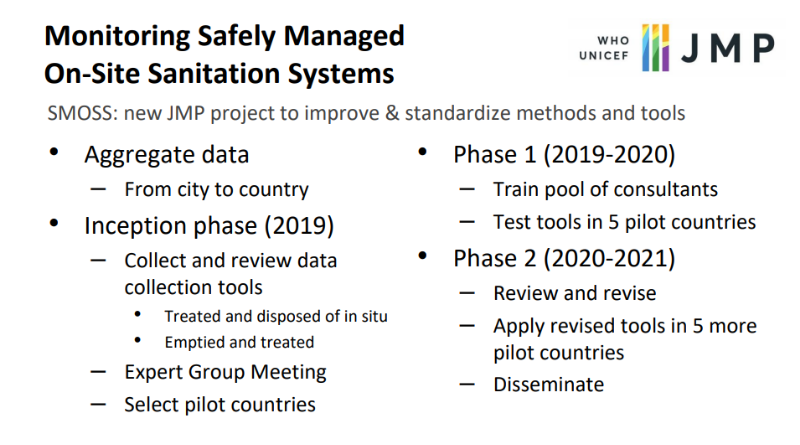 JMPslide.png
(Filesize: 178KB)
JMPslide.png
(Filesize: 178KB)
-
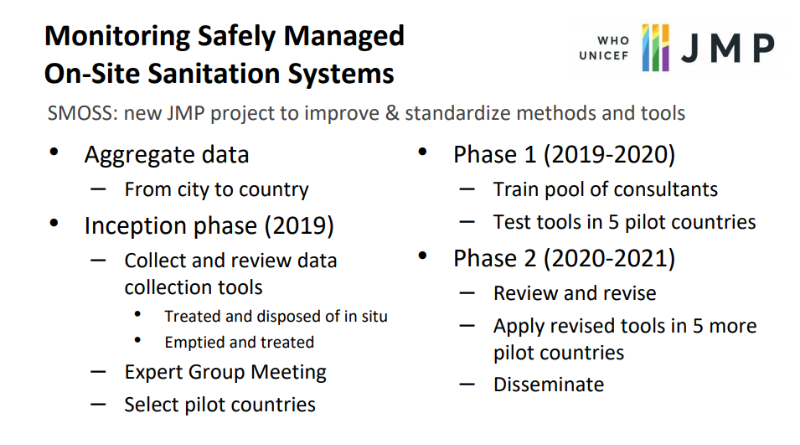 JMPslide_2...5-23.png
(Filesize: 178KB)
JMPslide_2...5-23.png
(Filesize: 178KB)
Please Log in to join the conversation.
You need to login to replyI would also add that a single pit cannot really be emptied safely in practical terms, but a twin pit can. I think it is illegal in India now to handle sludge from a pit, but decomposed humus from a twin pit is okay.
cheers
Dean
Vermifilter.com
www.vermifilter.com
Please Log in to join the conversation.
You need to login to reply- Elisabeth
-
- Moderator
- Freelance consultant since 2012 (former roles: program manager at GIZ and SuSanA secretariat, lecturer, process engineer for wastewater treatment plants)
Less- Posts: 3372
- Karma: 54
- Likes received: 931
Re: safely managed sanitation system in rural area
Regarding this question of yours:
Although the location of latrines with respect to water sources are commonly discussed, I have not found much on other potential risks related to location. For example, in our case, we assume that many pit latrines in our research site are located in very direct proximity of vegetable paths or agriculture fields. Does it pose any specific risks and should this be considered when assessing whether a latrine is safely managed or not?
With regards to agricultural fields the rule of thumb could be "the closer the toilet the better" - this is with regards to the reuse potential that you have here. We have many impressive photos showing how well banana plants do in proximity to a current or formerly used toilet pit!
See here:
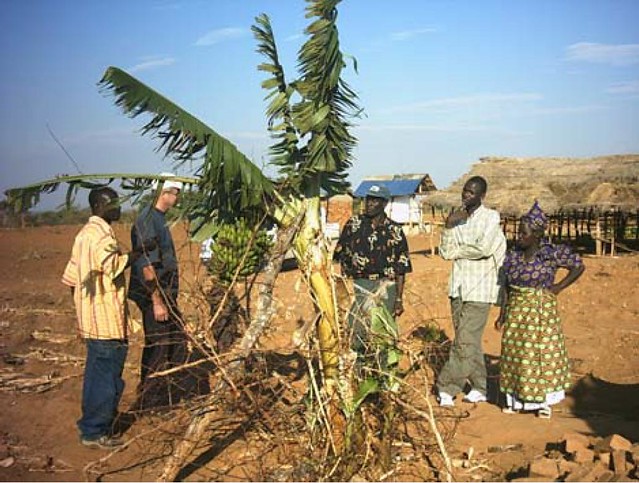
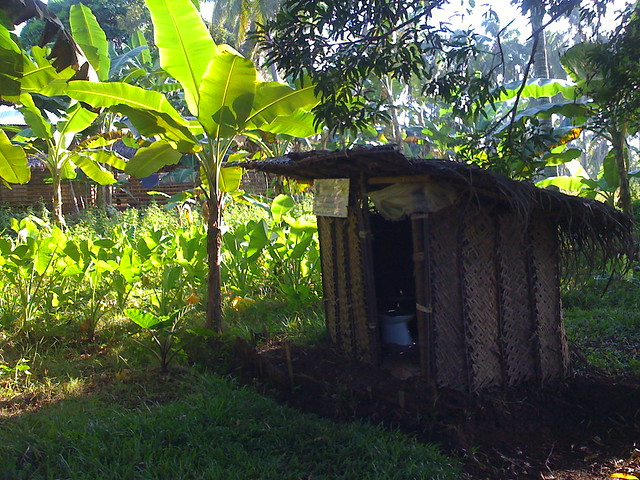
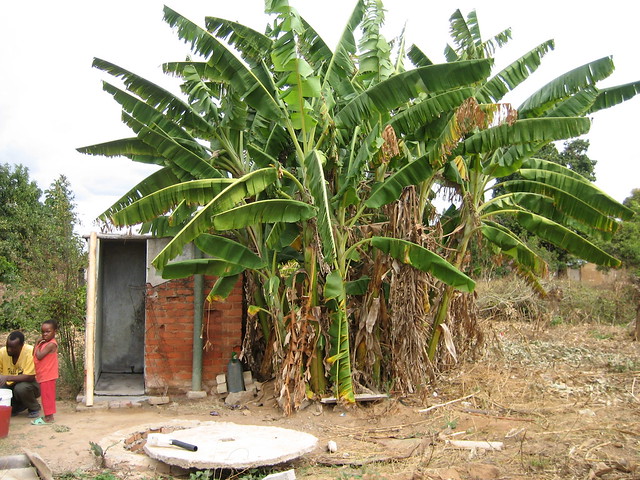
More photos here in these albums:
www.flickr.com/photos/gtzecosan/sets/72157618129740590/
and here:
www.flickr.com/photos/gtzecosan/sets/721...050/with/5567539266/
Regards,
Elisabeth
Freelance consultant on environmental and climate projects
Please Log in to join the conversation.
You need to login to replyOne can maintain 15 meters distance from toilet to own well or hand-pump. But quite difficult to maintain such threshold from neighbours well or hand-pumps. In India to maintain 15 meters distance in most of the rural areas is impossible due to very high population density.
pawan
Chairman
Foundation for Environment and Sanitation
Mahavir Enclave
New Delhi 110045, India
Web: www.foundation4es.org
Linked: linkedin.com/in/drpkjha
Please Log in to join the conversation.
You need to login to replyTo Elisabeth, based on our previous experience we expect that latrines in our Ethiopian research site (Sidama Zone, SNNPR, Ethiopia) are simple pit latrines which are not emptied.
Regarding the Hajo´s comment nm 2, I expect that many or most slabs in the research area are made of "wooden planks covered with soil". Your point is clear but I assume that this type of slab (if solid) still doesnt prevent a pit latrine to be considered as "safely managed" latrine according to JMP classification. As for the comment nm 4, this is also clear but to assess whether the location of a latrine is "safe" or not may obviously be tricky. We will probably use the 15 metres threshold from a well or hand-pump as suggested in one of the JMP advice sheets, although I think that the safe threshold may be quite context-dependent.
Regarding Pawn´s comments, water-seals are not common in our research site where almost all pit latrines are supposed to be dry latrines.
I have one more question related to location. Although the location of latrines with respect to water sources are commonly discussed, I have not found much on other potential risks related to location. For example, in our case, we assume that many pit latrines in our research site are located in very direct proximity of vegetable paths or agriculture fields. Does it pose any specific risks and should this be considered when assessing whether a latrine is safely managed or not?
Please Log in to join the conversation.
You need to login to replyToilet with unlined bottom or any leach pit toilet ( single or twin pit) should not be considered as safely managed sanitation system particularly for the areas having high ground water table and / flood affected as there is severe chance of ground water pollution from such toilets. In most of the rural areas, ground water is the only source of drinking water, such toilets may result in severe health hazards.
Such toilets with properly slab cover and water seal may be suitable for the areas having very low ground water table. In some states in India , where water table is very high and there is annual floods, leach pit toilets are not a suitable option.
Pawan
Chairman
Foundation for Environment and Sanitation
Mahavir Enclave
New Delhi 110045, India
Web: www.foundation4es.org
Linked: linkedin.com/in/drpkjha
Please Log in to join the conversation.
You need to login to reply- sarbagya111
-
Less
- Posts: 1
- Likes received: 0
Re: safely managed sanitation system in rural area
Please Log in to join the conversation.
You need to login to reply- hajo
-

- retired in Germany... but still interested in water and sanitation... especially in OSS... and especially in Africa...
Less- Posts: 288
- Karma: 15
- Likes received: 156
Re: specific definition of a "safely managed pit latrines" according JMP ladder for sanitation and guide how to detrmine it in practice
for me 'safely managed' includes:
- a slab which prevents people from falling into the pit or having contact to its contents;
- a slab which can easily be cleaned preventing people from carrying faeces with their feet to elsewhere, i.e. wooden planks covered with soil I would not consider safe (the distribution of ascari eggs can go this route);
- safe emptying of pits, generally they should not be emptied but if it's done it should prevent spillage on workers and into environment (and of course safe transport, treatment and reuse);
- latrine pits (and soakaways of septic tanks) should only be built in areas where the percolation of the effluent does not affect the groundwater otherwise people will get into contact with their excreta via the shallow wells or boreholes which provide them with (drinking) water (probably the cause of the recurrent cholera outbreaks in Lusaka/Zambia). Pit latrines which contaminate groundwater are not safely managed.
Hajo
Albert Einstein
Any intelligent fool can make things bigger and more complex... It takes a touch of a genius - and a lot of courage to move in the opposite direction.
E.F. Schumacher
Everything should be made as simple as possible, but not simpler.
Albert Einstein
Please Log in to join the conversation.
You need to login to reply- Elisabeth
-
- Moderator
- Freelance consultant since 2012 (former roles: program manager at GIZ and SuSanA secretariat, lecturer, process engineer for wastewater treatment plants)
Less- Posts: 3372
- Karma: 54
- Likes received: 931
Re: specific definition of a "safely managed pit latrines" according JMP ladder for sanitation and guide how to detrmine it in practice
Interesting discussion to ask about "safely managed". In your scenario in Ethiopia, are those latrines every emptied? If they are never emptied then this counts by definition as "safely managed". If they are emptied then you'd have to look at how are they emptied and where the fecal sludge is disposed of or treated? Do you already have any information on that?
It will be interesting to see how the definition of "safely managed" will evolve in practice.
Regards,
Elisabeth
Freelance consultant on environmental and climate projects
Please Log in to join the conversation.
You need to login to replyRe: specific definition of a "safely managed pit latrines" according JMP ladder for sanitation and guide how to detrmine it in practice
thanks for your response. As in our previous survey in Ethiopia, I think we would be able to distinguish improved pit latrines based on a solid slab (in the context of our research site slabs are mostly of wood and mud, rarely cemented). However, what may represent a safely managed pit latrine in that context comes quite unclear to me....
Best regards, Josef
Please Log in to join the conversation.
You need to login to reply- Forum
- categories
- Markets, finance and governance
- Global and regional political processes
- Sustainable Development Goals (SDGs), JMP monitoring
- specific definition of a "safely managed pit latrines" according to JMP ladder for sanitation and guide how to determine it in practice








